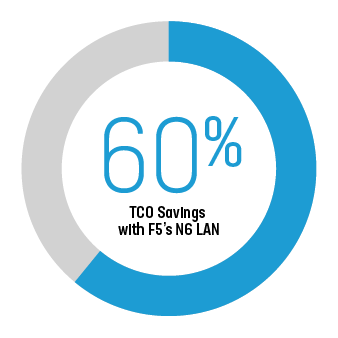RELATED CONTENT

Consolidate and Virtualize the S/Gi-LAN and N6 Functions
F5 provides the most comprehensive set of S/Gi-LAN/N6 services in a consolidated and virtualized solution.
F5’s N6-LAN consolidation solution helps service providers overcome key challenges in 5G edge deployments. Virtualization, consolidation, and automation make service orchestration easier, enabling service providers to take advantage of opportunities like per-subscriber policy enforcement.
Fast Track to the 5G Edge: N6 LAN Consolidation
Service providers are progressing through their 5G transformation journey, evolving from a combined 4G-5G non-standalone (NSA) architecture to 5G standalone (SA) networks that are designed for 5G from end to end. Enterprise use cases are becoming more prevalent, creating increased demand for edge services—deployed close to customers—ensuring that customers get the best possible performance and quality of experience (QoE) from the network.
With the increased need for edge services, scaling becomes the number one concern for service providers. Service providers who choose a multi-vendor, best-of-breed approach risk increasing the complexity of their 5G network architectures as a result of challenges with vendor interoperability. These interoperability issues can extend across every 5G Edge node in your network. These same interoperability issues can also reduce the benefits associated with virtualizing service provider networks, introducing additional points of failure into the system and making it difficult to scale. As a result, service providers could be faced with increases in both CapEx and OpEx, as well as delayed delivery of new services to subscribers, leading to loss of new revenue streams and lowered subscriber QoE. This is exactly why consolidating N6-LAN services is crucial; it allows service providers to build a fast, flexible, and high-performance network with improved opportunities for value-added services and new revenue streams.
N6 LAN Consolidation: Managing Data Traffic as it Traverses MEC Nodes
The N6 LAN is the portion of the 5G network that carries data from the User Plane Function (UPF) to the Internet. It performs the same function as the S/Gi-LAN does in a 4G network. This interface is also the point at which traffic comes across a number of very important network services, for example, subscriber security services, local DNS (LDNS), carrier-grade NAT (CGNAT), firewall and DDoS, TCP optimization and video traffic management. As service providers use multi-access edge computing (MEC) deployments in their 5G SA architectures to move services and applications to the edge of the network, they also move this interface, and the services it supports, to the edge. Given its roles and network placement, N6 LAN plays a critical role, enabling service providers to optimize their 5G networks (See Figures 1a and 1b).
Simplify the design, deployment,
and operation of critical network
functions at the edge.
• Subscriber security services
• Local DNS (LDNS)
• Load balancing
• Policy enforcement with intelligent traffic steering
• Carrier-grade network address translation (CGNAT)
• Firewall and DDoS
• TCP optimization
• Video optimization
Figure 1a: Prior to optimization, vendor interoperability issues can increase network complexity and TCO.
Figure 1b: : By simplifying the network, F5’s N6 LAN consolidated solution frees resources that can be used to create new revenue streams.
Because of the number of functions and diversity in types of functions that must be integrated, service providers face challenges deploying network functions on the N6 LAN, even with virtualization. It is complicated to deploy and manage disparate functions. Exacerbating the problem, a typical configuration acts on each function in a serialized, multi-hop way. This has an adverse effect on performance because it creates latency and requires a separate processor for each function. These challenges are compounded exponentially in MEC environments. With a dramatically larger number of deployments distributed across sites with limited footprints and compute resources, it is challenging for MEC environments to deliver on their strict performance characteristics, such as lower latency.
F5 offers a full-suite N6 LAN and S/Gi-LAN solution that virtualizes and consolidates the widest range of services available for each interface and automates and manages the services with the F5 NF Manager. This solution allows simplified and optimized service orchestration, better application availability, improved performance and security, and service deployment agility, while achieving higher throughput and low latency. These efficiency and performance improvements can be used to deliver enhanced mobile broadband services to customers, as well as enabling other service enhancement opportunities.
F5 offers a full suite N6 LAN and S/Gi-LAN solution that virtualizes and consolidates the widest range of services available for each interface and automates and manages the services with the F5 NF Manager.
Per-subscriber policy enforcement—N6 LAN also plays a crucial role in per-subscriber policy enforcement. F5’s solution enables a per-subscriber traffic identification capability. Service providers can use this capability to offer per-customer security policies, such as parental controls, tiered traffic for gold, silver, or bronze account options, and management of prioritization by traffic type for video conferencing applications like Zoom.
From a service provider’s point of view, the N6 LAN consolidation solution is important because it maximizes N6 LAN efficiency and provides distinct operational benefits. In several customer case studies, F5 recorded a 60% TCO reduction. These savings come from simplified network design, orchestration, and management; convenient deployment of new services and software upgrades; lower CPU usage; a single-hop architecture; a “zero copy” memory, which optimizes resource consumption; and simplified troubleshooting.

Savings From Consolidating Containerized Services
• Lower CPU usage
• Fewer CPU hops, minimizing latency
• “Zero Copy” memory architecture optimized resource consumption
• Network simplification, easier orchestration and management
• Simplified troubleshooting
• Easier to implement new services, software upgrades
Figure 2: The N6 LAN consolidation solution provides distinct architectural and operational improvements in the N6 (or S/Gi LAN) environment that substantially improve efficiency and performance substantially for customers. In case studies conducted with several F5 customers, service provider TCO was reduced by 60%.
Best-of-Suite N6-LAN Edge Solution with F5
As deployment complexity increases, service providers will turn to industry partners to help them build new infrastructure and deliver services at the edge. To be successful, they need specialized solutions and expertise to implement a robust 5G edge. An efficient, containerized N6 LAN solution from F5 helps service providers build a cost-effective edge that reduces time to market for new services and resolves issues with network complexity.